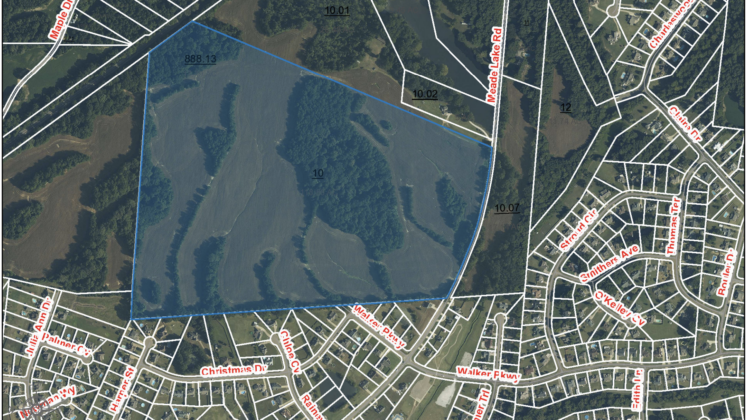

There was no shortage of opposition to a proposed subdivision in Atoka at the city’s planning commission meeting last week.
The 344-lot planned unit development would put a mix of different types of single-family homes with three common open spaces – two of those with playgrounds – on 122 acres of farmland just north of Templeton Farms on Meade Lake Road.
Wilbanks Architecture & Associates Project Engineer Kyle Ham spoke at the meeting on behalf of Investor Nation, which owns the property. The group is asking for the property to be rezoned to accommodate their proposal.
“We wanted to get the R2 lots in there, so a smaller lot than what’s allowed in the agricultural, but also with the (planned development) we get smaller lot sizes then we provide the amenities,” he said.
Planned unit developments, which are often called PUDs, are new in Atoka. Commissioner John Harber, who is a general contractor who specializes in residential construction, said with the PUD the zoning will remain the same and will give the city increased control of what happens. While some viewed the zero lot line, townhome-style structures as low quality construction and will attract lower income buyers and more crime, Harber said those types of properties generally attract single, childless individuals who didn’t want the hassle of yardwork.
“The planning commission will act as a design review commission and so we actually have architectural oversight … so that, basically, quality homes are being built.”
It would also require the extension of Walker Parkway, which would go right through the proposed development, a measure that has had mixed reaction for several years.
The opposition to the project from residents, the majority of whom live in neighboring Templeton Farms and Blaydes Estates, involved increased traffic in the area, increased demand on already strained public safety departments and stretching the limits of the town’s infrastructure.
Traffic
There was considerable discussion about traffic in the residential areas of town, which are consistently congested during the morning and evening rush hours.
With 344 new homes, and the nearly 200 homes in another subdivision in the area that was already approved, there would be 600 to 700 more vehicles in the area in the coming years.
Ham provided the town with a 40-page traffic study, however Harber said part of the study included roadways not yet constructed and neglected to include others.
“We were given this thick traffic study with roundabouts on Walker Parkway that are not even there yet and, in my opinion, left out the most critical, obvious element in the room and that is Meade Lake at Atoka-Idaville. I’ve already asked them to go back and review that.”
Commissioner Vicki Shipley could be heard in the background saying the intersection was “a hot mess.”
Design engineer Ben Ledsinger said it would be difficult to get an improvement in the traffic pattern at the intersection because it was a railroad bridge on a state highway. The geometry of the bridge, he said, causes lower visibility and backups.
One of the primary benefits of the subdivision would be the east-west connector, said commissioner Jonathan Fortenberry.
Ham said the company intended to begin building the first phase later this year and their intent was to build the homes as quickly as they could.
In 2018, a proposed 108-home subdivision in the same area was not approved due to traffic concerns and lack of adequate sewer capability.
In tears Beth Zvolanek, who lives on Meade Lake near the property, told the board she feared for the safety of her children with hundreds more vehicles on the roads.
“The traffic impact is minimal until they hit my family pulling out from a blind curve. That’s 600 more chances for them to hurt my babies, 600 more cars at a bare minimum for somebody to be speeding around the curve at Meade Lake and smack into us as we pull out of our driveway … You should really consider the lives that could be impacted.”
Public safety
In addition to the increased traffic which could slow response times for first responders, Atoka Fire Department Lt. Bill Scott said one concern is the proximity of the zero lot line homes to one another.
“The smaller setback, smaller space between is a concern for the fire department,” he said. “At that point, instead of one on house on fire we have two look at three houses on fire, we have to look at five houses on fire because of the density of that subdivision.”
Infrastructure
Aside from traffic, many residents were very concerned about the city’s infrastructure.
While public works director Dalton Patrick told the group the software said the proposed plan would work with the city’s existing wastewater system, its capacity was questioned several times by the 16 residents who spoke.
“Before you approve a project this big, I would highly recommend you get somebody that can definitely give you an answer whether or not it can take the sewage,” said Susan Payne, a resident of Templeton Farms who said the subdivision sees sewage backups during times of heavy rain. “Just don’t take the word of somebody who said ‘I think it’s gonna work.’ We need somebody who can definitely say ‘Yes, it’s gonna work. Yes, we have the capacity to feed everything … Can it take on all that added strain it’s gonna put on a gravity-fed system?”
Some residents are concerned about stormwater runoff.
Another concern for residents of Kearns Circle, which frequently experiences flooding from Big Creek, is how the two new subdivisions and their retention ponds will affect the floodplain and the creek.
“It looks like a smoke and mirror to me,” said Templeton Farms resident Scotty Cooper. “It looks like the way to get a free street for the Town of Atoka. There’s your east-west connector.”
Cooper also told the board a petition had been filed to stop the development.
“We’ve got it made, we’ve got a great town but we’re behind the times. We’re short police, fire, we all know … We keep building homes, homes, homes and we don’t do anything else. I ask you to take a break, put it on hold, get the sewer together and everything (else) we need.”
Some residents said the town wasn’t doing enough to take care of the infrastructure and the people who currently reside in Atoka.
“If you don’t take care of the people you’ve got here, you’ll have people leaving. That’s what I’m concerned with,” Cooper said. “The people on Julia Ann are pumping, the people on Kearns are flooding. You’ve got to take care of your own first, then build for the new people is the only thing I’ve got to say.”
The planning commission voted to table the decision and is expected to discuss it again at its Feb. 17 meeting.
Harber said he wanted to see a traffic study for Meade Lake at Atoka-Idaville. Commissioner Keith Moore wanted to feel better about some of the open-ended items.
The commission will forward a positive or negative recommendation to the board of mayor and aldermen.
For more information, and to see the proposal, visit townofatoka.com.






Leave a Reply